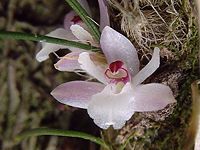Isabelia
| Leptotes | ||||||||||||||||||||
|---|---|---|---|---|---|---|---|---|---|---|---|---|---|---|---|---|---|---|---|---|
 Isabelia virginalis
| ||||||||||||||||||||
| Scientific classification | ||||||||||||||||||||
| ||||||||||||||||||||
| Type species | ||||||||||||||||||||
| Isabelia virginalis Barb. Rodr. 1877 | ||||||||||||||||||||
| Species | ||||||||||||||||||||
| ||||||||||||||||||||
| Synonym | ||||||||||||||||||||
Isabelia is an orchid genus formed by three tiny species and one natural hybrid, spread from Northeast of Brazil to Argentina, which are closely related to the genus Constantia. During more than a century Isabelia was a genus formed by just one species, however, around 1978, it was merged with genus Neolauchea, also unispecific. In 2001, a third genus was added to it, Sophronitella.
Distribution
Isabelia are epiphyte or rarely rupicolous species, spread in Atlantic Forest of Brazil from north Bahia to Rio Grande do Sul, both in the humid slopes of Serra do Mar and in the drier forests of Brazilian Plateau, from sea level to fifteen hundred meters of altitude; I. virginalis also found in Paraguay and north of Argentina.
Isabelia violacea is more common growing epiphytically at the streams banks jungles of campos rupestres of Minas Gerais State at around eleven hundred meters of altitude;
Isabelia virginalis in often found epiphytically in semi deciduous forest in São Paulo and Paraná from two to five hundred meters of altitude but can reach fifteen hundred in Minas Gerais mountains not rarely living as a lithophyte at these elevations. It grows both on main stems and mid height and high branches of trees, where it is exposed to plenty of luminosity, humidity and ventilation.
Isabelia × pabstii State of Paraná, Brazil.
Description
Isabelia have unifoliated ovoid to fusiform pseudobulbs; linear or acicular leaves; inflorescence bearing one of few flowers. The flowers the petals sepals and labellum of the same color, wich can be white, pale pink or magenta. Their sepals are widely elliptical to ovate, the petals can be narrower and oblong or wider elliptic. The labellum is entire and oblong. The labellum may be entirely free of partially fused to the column forming a nectary. The column is darker than the rest of the flower and may have four or eight pollinia.[1]
All Isabelia species bloom in the autumn and their flowers last for about a week. Nothing is known about their pollinators. They have no known uses other than horticultural. Isabelia species are not very easy to cultivate. All species can be grown mounted on vegetable plaques and need plenty of humidity and ventilation and moderate to high luminosity.
Taxonomic notes
The first species of Isavelia to be discovered was I. virginalis. Despite having been collected in Serra dos Órgãos, Rio de Janeiro and sent to Europe by George Gardner, in 1837, for some unknown reason, Isabelia virginalis remained without a formal description and scientific name until 1877,[2] when João Barbosa Rodrigues found several specimens of it in Caldas, Minas Gerais on the trees around jungle clearances.[3] The name of this genus is an homage to Isabel, the Princess of Brazil, the daughter of D. Pedro II, Emperor at the time Barbosa Rodrigues published his book.
Senghas and Teuscher. Cassio 2001.
According to Cássio van den Berg, who studied their phylogeny, Isabellia is closely related to Pseudolaelia and Constantia and all three form a sister clade to another small clade that includes Leptotes and Loefgrenianthus.[4] The two clades constitute Isabellia alliance, formed by plants that share stout columns, sometimes partially adnate to the labellum forming round nectaries, and is one of the eight clades of subtribus Laeliinae.[1]
Species
Although the three species of Isabelia share several morphological characteristics, they are highly different from each other and very easy to identify, both through the vegetative qualities or from particularities on their flowers. Despite all species today are subordinated to the same genus, many orchid collectors keep using the former names. The reason to unify the genera was to make clear their close relationship and to reduce the number of accepted genera, however, the use of former genera names does not imply in any inconvenience towards phylogenetic classification and does not create polyphyletic genera.
The former genus Neolauchea, whose only species is now Isabelia pulchella, is the only with elongated rhyzome, therefore, very spaced pseudobulbs, toped by a highly narrow and long concave leave that almost seems to be terete at first sight. Their ovaries become visibly swallowed at their junction to the column foot where the base of the labellum is partially fused forming a nectary. It has four pollinia.
Former Sophronitella species, now Isabelia violacea, is the largest species of Isabelia; with a short rhyzome, more robust and erect pseudobulbs, with an almost flat leathery leaf. This species is the only to show more than one flowers per inflorescence, up to three. It has a free labellum and eight pollinia.
The core Isabelia species, Isabelia virginalis, presents short reptant rhyzome with pseudobulbs of terete leaves, completely covered by dried stealths formed by a loose tissue of fibers interlaced as a rustic network. Their labelli are partially fused to the column forming a nectary. Their flowers have eight pollinia.[5]
There is a natural hibrid of I. pulchella with I. violacea, previously known as Isanitella × pabstii, now called Isabelia × pabstii.
References
- ↑ 1.0 1.1 Van den Berg, Cássio: Isabelia in Genera Orchidacearum Vol.4, pp. 360-2. Oxford University Press, 2006. ISBN 9780198507123.
- ↑ Miller, David; Richard Warren; Izabel Moura Miller & Helmut Seehawer (2006) Isabelia violagea in Serra dos Órgãos sua história e suas orquídeas, p. 235. Rio de Janeiro.
- ↑ Barbosa Rodrigues, João: Isabelia virginalis in Genera et species orchidacearum novarum Vol.1, p.75. 1877. Published on the Internet, in French and Latin.
- ↑ Van den Berg, Cássio et al: A Phylogenetic analysis of Laellinae based on sequence data from internal transcribed spacers of nuclear ribosomal DNA in Lindleyana vol.15-2, pp. 96–114, 2000. Published on Internet.
- ↑ Johnson, Andrés E.: Isabelia virginalis in Las orquídeas del Parque Nacional Iguazú, pp. 102-3. Fundación Vida Silvestre Argentina, Buenos Aires, 2001. ISBN 9509725412